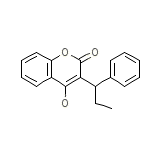Phenprocoumarol




Phenprocoumarol Brand names, Phenprocoumarol Analogs
Phenprocoumarol Brand Names Mixture
- No information avaliable
Phenprocoumarol Chemical_Formula
C18H16O3
Phenprocoumarol RX_link
No information avaliable
Phenprocoumarol fda sheet
Phenprocoumarol msds (material safety sheet)
Phenprocoumarol Synthesis Reference
No information avaliable
Phenprocoumarol Molecular Weight
280.318 g/mol
Phenprocoumarol Melting Point
179.5 oC
Phenprocoumarol H2O Solubility
12.9 mg/L
Phenprocoumarol State
Solid
Phenprocoumarol LogP
4.59
Phenprocoumarol Dosage Forms
Tablet
Phenprocoumarol Indication
Used for the prevention and treatment of thromboembolic disease including venous thrombosis, thromboembolism, and pulmonary embolism as well as for the prevention of ischemic stroke in patients with atrial fibrillation (AF).
Phenprocoumarol Pharmacology
Phenprocoumon, a coumarin anticoagulant, thins the blood by antagonizing vitamin K which is required for the production of clotting factors in the liver. Anticoagulants such as phenprocoumon have no direct effect on an established thrombus, nor do they reverse ischemic tissue damage (damage caused by an inadequate blood supply to an organ or part of the body). However, once a thrombus has occurred, the goal of anticoagulant treatment is to prevent further extension of the formed clot and prevent secondary thromboembolic complications which may result in serious and possibly fatal sequelae.
Phenprocoumarol Absorption
Bioavailability is close to 100%
Phenprocoumarol side effects and Toxicity
50=500 mg/kg. Symptoms of overdose includes suspected or overt abnormal bleeding (e.g., appearance of blood in stools or urine, hematuria, excessive menstrual bleeding, melena, petechiae, excessive bruising or persistent oozing from superficial injuries).
Phenprocoumarol Patient Information
The objective of anticoagulant therapy is to decrease the clotting ability of the blood so that thrombosis is prevented, while avoiding spontaneous bleeding. Effective therapeutic levels with minimal complications are in part dependent upon cooperative and well-instructed patients who communicate effectively with their physician. Patients should be advised: Strict adherence to prescribed dosage schedule is necessary. Do not take or discontinue any other medication, including salicylates (e.g., aspirin and topical analgesics), other over-the-counter medications, and botanical (herbal) products (e.g., bromelains, coenzyme Q10, danshen, dong quai, garlic, Ginkgo biloba, ginseng, and St. John's wort) except on advice of the physician. Avoid alcohol consumption. Do not take phenprocoumon during pregnancy and do not become pregnant while taking it. Avoid any activity or sport that may result in traumatic injury. Prothrombin time tests and regular visits to physician or clinic are needed to monitor therapy. Carry identification stating that phenprocoumon is being taken. If the prescribed dose of phenprocoumon is forgotten, notify the physician immediately. Take the dose as soon as possible on the same day but do not take a double dose of phenprocoumon the next day to make up for missed doses. The amount of vitamin K in food may affect therapy with phenprocoumon. Eat a normal, balanced diet maintaining a consistent amount of vitamin K. Avoid drastic changes in dietary habits, such as eating large amounts of green leafy vegetables. Contact physician to report any illness, such as diarrhea, infection or fever. Notify physician immediately if any unusual bleeding or symptoms occur. Signs and symptoms of bleeding include: pain, swelling or discomfort, prolonged bleeding from cuts, increased menstrual flow or vaginal bleeding, nosebleeds, bleeding of gums from brushing, unusual bleeding or bruising, red or dark brown urine, red or tar black stools, headache, dizziness, or weakness. If therapy with phenprocoumon is discontinued, patients should be cautioned that the anticoagulant effects of phenprocoumon may persist for about 2 to 5 days.
Phenprocoumarol Organisms Affected
Humans and other mammals














